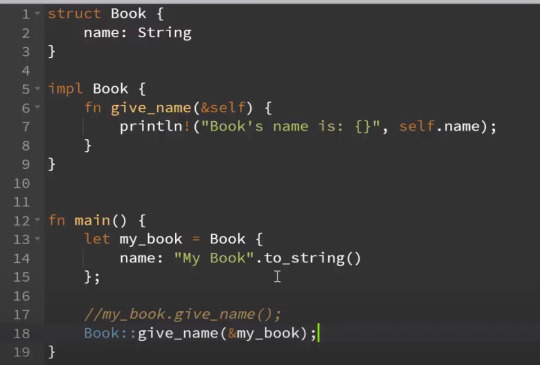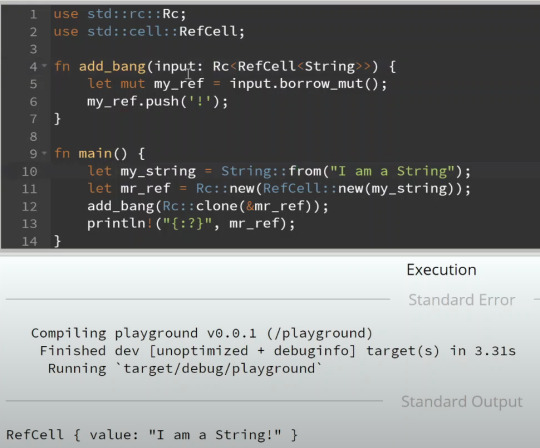#concurrency
Text
Unlike 99% of human languages, computer languages are designed. Many of them never catch on for real applications. So what makes a computer language successful? Here's one case study...
#software development#software engineering#golang#coding#artificial language#concurrency#google#programming languages#compiler#computing history#mascot#gophers
3 notes
·
View notes
Text
Virtual Threads and Structured Concurrency in Java
So I was curious about virtual threads and the structured concurrency API that is being introduced to Java so I did some research and wrote some things about it on my Dev.to blog. Check it out!
#java#development#web development#webdev#coding#programming#java programming#structured concurrency#concurrency#codeblr
2 notes
·
View notes
Text
RUST 113-121 in english
type, use, as

위는 축약전
아래는 type , use 를 사용해서 줄인 코드



todo!

위 에러 발생

위 작동 잘함

unimplemented 와 같은 효과 todo
Rc

위 struct의 impl 된 함수의 경우 마치 Class 함수처럼 접근도 가능하다



위 Rc , RefCell 를 같이 사용한 경우
thread

위의 경우 main함수가 두개의 thread 가 작업을 끝낼때 까지 기다리지 않고
함수 끝에 도달하면 프로그램은 멈추게 된다

join 을 통해 thread 작업이 마무리 될때 까지 기다린







순차적으로 쓰레드가 끝나는걸 보면 진정한 concurrency 가 아니다

위 concurrency
2 notes
·
View notes
Video
youtube
Learn Java Multithreading in HINDI | Java Multithreading Tutorial in Hi...
Hi, a new #video on #java #multithreading is published on #codeonedigest #youtube channel. Complete #tutorial about java multithreading for #beginners & #students.
#java #javamultithreading #multithreading #javamultithreading #javamultithreadingtutorial #javamultithreadinginterviewquestions #javamultithreadingproject #javamultithreadingandconcurrencytutorial #javamultithreadingcompletetutorial #javamultithreadinginHindi #JavainHindi #Hindi #multithreadinginHindi #javamultithreadingsynchronization #javamultithreadingprogram #multithreadinginjava #multithreading #multithreadinginoperatingsystem #multithreadingmodelinoperatingsystem #multithreadinginos #multithreadingprograminjava #multithreadinginjavainhindi #threadsynchronizationinjava #threadsynchronization #threadsynchronisation #threadsynchronizationinpython #threadsynchronizationinjavaprogram #threadsynchronizationindistributedsystems #threadsynchronizationinoperatingsystem #threadsynchronizationinjavainhindi #threadsynchronizationinhindi #threadsynchronizationinos
#youtube#java#multithreading#multithread#multiple thread#java multithreading#thread synchronization#single thread vs multi thread#master thread#worker thread#daemon therad#thread priority#thread register#thread stack#process vs thread#concurrency#thread concurrency
2 notes
·
View notes
Link
Coroutines in action with Kotlin
0 notes
Text
Java Interview Questions on Multithreading and Concurrency for Experienced Developers
Java Interview Questions on Multithreading and Concurrency. Here are some advanced interview questions on multithreading and concurrency suitable for candidates with 10 years of Java experience.
Can you explain the difference between parallelism and concurrency in the context of multithreading?
In the context of multithreading, parallelism, and concurrency are related but distinct…
View On WordPress
#Best Practices#concurrency#interview#interview questions#Interview Success Tips#Interview Tips#Java#Microservices#multithreading#programming#Senior Developer#Software Architects
0 notes
Text
Should You Change Lock Escalation Behavior to Fix SQL Server Blocking Issues?
Introduction
Have you ever encountered blocking problems in your SQL Server databases due to lock escalation? As a DBA, I certainly have! Lock escalation can cause queries to grind to a halt as they wait for locks, slowing down the entire system. It’s a frustrating issue, but luckily there are ways to address it. In this article, we’ll take an in-depth look at lock escalation – what causes it,…
View On WordPress
0 notes
Text
Why Choose Elixir For Your Next Software Development Project? - Technology Org
New Post has been published on https://thedigitalinsider.com/why-choose-elixir-for-your-next-software-development-project-technology-org/
Why Choose Elixir For Your Next Software Development Project? - Technology Org
Choosing the right programming language for your project is probably one of the most difficult choices to make. Your tech stack will define your project for many years to come. An incorrectly chosen programming language can make your project slow and uncomfortable for an average user. In this post, we would like to discuss a language that, in our opinion, fits the majority of modern projects well. This language is Elixir. Read further to find out what key positive features it has and what the key reasons to use it for your next development project are.
Software development – illustrative photo. Image credit: Innovalabs via Pixabay, free license
Reason 1. Great concurrency and scalability.
The first reason to use Elixir as a programming language is undoubtedly its focus on concurrency and scalability. Firstly, Elixir is great at launching multiple processes simultaneously. This means that it can work with numerous customers doing a similarly large range of tasks. For example, if you have a web app that offers streaming and chat capabilities at the same time, Elixir is a strong option to consider. It can handle the simultaneous launching of code for both presented features. Secondly, Elixir is well-known for its low-weight processes. What does this mean? Its code doesn’t take up much space in RAM. As a result, it’s easy to scale projects that are written in Elixir. You can add multiple features before they become too extensive for the app. Consequently, Elixir is great for Software as a-service options on the market because it enables long-term development. The most successful web apps are being constantly upgraded. Elixir is one of the best languages for this model of long-term updating.
Reason 2. Ease and speed of programming
Another important reason to use Elixir is undoubtedly the ease of programming. The creators of Elixir looked at multiple different programming languages to create a high-quality syntax for their project. In this respect, Elixir took some of the best features from Python and Ruby: consequently, its structure is both familiar for experienced developers and, more importantly, easy-to-learn for newcomers. Due to its high-quality syntax, Elixir’s code has many major advantages. Firstly, it’s easy to read: even non-specialists can quickly start understanding what the developers want to do with this or that line of code. Secondly, it reduces development time by making many elements of code easy to write. Elixir’s code is clean and understandable; it also takes fewer lines than expected of other frameworks. All this contributes to the great maintainability of the language. With Elixir development services, the problem of relying too much on one development team is typically non-existent. A properly written Elixir code can be picked up by any specialist quickly and brought into production easily.
Reason 3. Fault-tolerant programming
Elixir is written over Erlang VM. Erlang is a programming language that heavily focuses on stability. Elixir, which uses its own VM, retains this core feature of Erlang. So, how does Elixir benefit from the core features of Erlang? In this regard, the presented language, above all, is very fault-tolerant. It uses the so-called actor model of concurrency, which, in many ways, prevents the majority of the problems modern programming languages encounter in terms of stability. The Erlang VM splits all tasks into separate groups and creates a clear hierarchy for them. It isolates processes so that the failure of one process doesn’t lead to the failure of an entire program. In this light, the projects made with Elixir become highly stable. Even if several components of them fail due to some reason, the entire app or website won’t collapse. Moreover, Elixir and Erlang VM will immediately launch processes aimed at restoring your app. In this way, you get an opportunity to create apps that work in high-stress environments with unpredictable loads.
Reason 4. Great access to libraries
Elixir is well-known for its great access to various libraries. Firstly, it has a small but dedicated community of developers who create platform-specific extensions. There are now more and more tools for adapting this language to the demands of Internet development. Secondly, and more importantly, Elixir provides you with access to the tremendous number of libraries connected to Erlang. Over the preceding years, Erlang has been battle-tested in the telecom sector. This means it has many relevant libraries. For many years, those unique extensions were available only to Erlang developers, who mostly worked in telecom. The core revolution of Elixir is that it provides access to such innovations to a wide audience. This genuinely unique library choice is perfect when your core goal is to create a project that will have to withstand significant outside pressure and maintain stability at the same time.
Core sectors in which Elixir works great
In our opinion, Elixir is notable for its great flexibility. In many ways, it’s suitable for the majority of development tasks outside high-CPU-load apps. It’s especially potent in three sectors: web development, IoT creation, and telecommunications. Firstly, we recommend Elixir for a wide range of web apps. In one way or another, Elixir is one of the best languages when you need to create an app that can withstand large amounts of outside pressure. Secondly, Elixir is a strong option to consider for the Internet of Things. IoT devices often perform vital functions for their users. As a result, any issues with their long-term functioning can be debilitating. If the software of a smart fridge fails, the user may easily lose high-value food. Elixir solves this problem by being highly fault-tolerant: situations where entire apps collapse in this framework are almost non-existent. Consequently, it’s possible for the Elixir app to be stable for months and even years of uptime. Lastly, Elixir is great for various communication projects. In this regard, it greatly benefits from Erlang features.
Conclusion
All in all, you should definitely try using Elixir for your future projects. Why? The reason is simple: it’s among the best programming languages on the market. How should you search for experts in this field? Seek companies that develop using Elixir and have multiple years of experience with creating online projects. In this respect, we can recommend Keenethics. This company has several years of experience developing web and mobile projects, using a diverse tech stack, which also includes Elixir.
#app#apps#code#communication#Community#Companies#Concurrency#cpu#creators#developers#development#development project#devices#easy#Experienced#extensions#Features#Food#framework#Future#how#innovations#Internet#Internet of Things#IoT#IoT devices#issues#it#language#Languages
0 notes
Text
A proposal (started 4/2023) for a new JVM API for structured concurrency, which "treats groups of related tasks running in different threads as a single unit of work, thereby streamlining error handling and cancellation, improving reliability, and enhancing observability." Goals: Help eliminate common risks arising from cancellation and shutdown, such as thread leaks and cancellation delays. Improve the observability of concurrent code. Read its "Motivation" section for a concrete example where this helps.
0 notes
Text
Unveiling the Future of JVM Technology: Innovations and Directions
Are you curious about the future of Java Virtual Machine (JVM) technology and the exciting innovations it holds? As the backbone of Java-based applications, the JVM continues to evolve, paving the way for groundbreaking advancements in the world of programming. In this article, we'll delve into the future directions and innovations in JVM technology that are poised to shape the landscape of software development.
The Evolution of JVM Technology
Since its inception, the JVM has undergone significant evolution, enabling developers to write platform-independent code and execute it seamlessly across diverse environments. From performance enhancements to advanced garbage collection algorithms, each iteration of the JVM has brought forth new capabilities and optimizations, empowering developers to build robust, scalable, and efficient applications.
Future Directions in JVM Technology
Looking ahead, several key trends and innovations are set to redefine the future of JVM technology:
Project Loom:
Project Loom aims to revolutionize concurrency in Java by introducing lightweight, user-mode threads known as fibers. By reducing the overhead associated with traditional threads, fibers promise to improve the scalability and responsiveness of Java applications, particularly in highly concurrent scenarios such as microservices and reactive programming.
GraalVM:
GraalVM represents a groundbreaking initiative that offers high-performance, polyglot execution capabilities on the JVM. With support for multiple programming languages, including Java, JavaScript, Python, and Ruby, GraalVM enables developers to seamlessly integrate different language runtimes within a single application, unlocking new possibilities for interoperability and productivity.
Project Panama:
Project Panama aims to enhance the interoperability between Java and native code, enabling seamless integration with libraries and frameworks written in languages such as C and C++. By providing efficient access to native data structures and functions, Project Panama facilitates the development of high-performance, low-level components within Java applications, such as multimedia processing and system-level programming.
Ahead-of-Time (AOT) Compilation:
AOT compilation is gaining traction as a promising approach to improving startup times and reducing memory footprint in Java applications. By precompiling Java bytecode into native machine code, AOT compilation eliminates the need for just-in-time (JIT) compilation at runtime, resulting in faster startup times and improved overall performance, particularly in resource-constrained environments such as cloud-based deployments.
Embracing the Future of JVM Technology with The Tech Tutor
At The Tech Tutor, we're committed to empowering developers with the knowledge and skills they need to thrive in a rapidly evolving technological landscape. Our comprehensive courses and tutorials cover a wide range of topics, including JVM internals, performance optimization, and the latest advancements in Java ecosystem.
Whether you're a seasoned Java developer looking to stay ahead of the curve or a newcomer eager to explore the exciting world of JVM technology, The Tech Tutor has you covered. Join our community today and embark on a journey of continuous learning and innovation in JVM technology.
Conclusion
As JVM technology continues to evolve, developers can expect to see a myriad of innovations that enhance performance, scalability, and interoperability in Java-based applications. From Project Loom's revolutionization of concurrency to GraalVM's polyglot execution capabilities, the future of JVM technology is brimming with possibilities.
Stay ahead of the curve and embrace the future of JVM technology with The Tech Tutor. Explore our comprehensive courses and tutorials to unlock your full potential as a Java developer and shape the future of software development.
#JVMTechnology#Java#FutureInnovations#ProjectLoom#GraalVM#ProjectPanama#AOTCompilation#Programming#SoftwareDevelopment#TechTrends#TheTechTutor#JavaDevelopers#Concurrency#PolyglotExecution#ContinuousLearning#DeveloperCommunity
1 note
·
View note
Text










#fem boy#princess#edm#dubstep#jack pruett#bass#eclipse-trips#trap#Sinaesthetic#Los Angeles#San Fransisco#Hyperthread#Botsch#xxsniffles#natural presence#ourmutt#concurrency#model#fashion#irregularity records#goth#Gucci goth collective#Danimal#Dan Man Alive#Spotify
0 notes
Text
Are you a student or aspiring developer eager to unlock the secrets of modern C++ for efficient and error-free code? 🤖 Look no further!
In our latest blog post, we delve into the dynamic world of concurrency, introducing you to the powerful tools of latches and barriers in C++20. Discover how these synchronization mechanisms can streamline your code and help you create software that runs smoothly.
0 notes
Text
Multitasking Machines

"Humans can’t multitask like computers do, and yet our bodies just keep on functioning."
Read the full article at… falterinresolute.com
And follow for new bite-sized philosophy articles every few days…
0 notes
Text

What is lock interface in Concurrency API in Java?
.
.
.
.
For more questions about Java
https://bit.ly/3Lcw553
Check the above link
#runnableinterface#callableinterface#concurrency#shutdownhook#javabean#multithreading#strictfp#lightweightcomponent#thread#process#heavyweightcomponent#reflection#Classclass#Systemclass#wrapperclass#boxing#unboxing#objectcloning#serialization#polymorphism#java#constructor#thiskeyword#computersciencemajor#javatpoint
0 notes
Text
Example of async Langchain usage regardless of target LLM. Almost all the examples I see out there of LC usage are serialized/blocking. Not really modern programming. For me it really should be asynchronous for real-world use. LC does include aync facilities, but they're limited to the few LLM APIs & server sides which are already async instrumented. Here is sample code to always be able to use async on the client side, regardless of the back end.
#artificial intelligence#code#python#concurrency#asyncio#langchain#large language models#llm#ai tools#programming
0 notes
Link
Some notes on my efforts to implement the Gamma function 𝚪(z).
1 note
·
View note